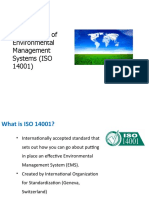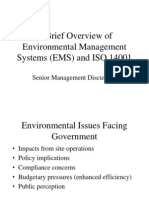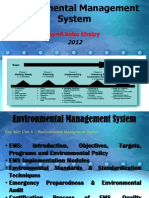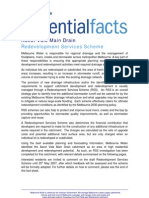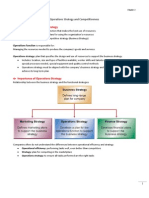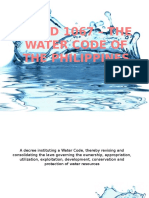0 ratings0% found this document useful (0 votes)
32 viewsModule 3
This document outlines the key elements and requirements of an environmental management system (EMS). It discusses the main clauses of an EMS including environmental policy, planning, implementation, checking, and management review. It also summarizes the fundamental elements of an EMS such as commitments to compliance, prevention of pollution, identifying environmental aspects and impacts, legal requirements, objectives and targets, environmental management programs, structure and responsibility, training and awareness, documentation, and operational control. Additional elements covered include emergency preparedness, monitoring and measurement, corrective action, records, auditing, and management review.
Uploaded by
Muhammad JahanzaibCopyright
© © All Rights Reserved
Available Formats
Download as PDF, TXT or read online on Scribd
0 ratings0% found this document useful (0 votes)
32 viewsModule 3
This document outlines the key elements and requirements of an environmental management system (EMS). It discusses the main clauses of an EMS including environmental policy, planning, implementation, checking, and management review. It also summarizes the fundamental elements of an EMS such as commitments to compliance, prevention of pollution, identifying environmental aspects and impacts, legal requirements, objectives and targets, environmental management programs, structure and responsibility, training and awareness, documentation, and operational control. Additional elements covered include emergency preparedness, monitoring and measurement, corrective action, records, auditing, and management review.
Uploaded by
Muhammad JahanzaibCopyright
© © All Rights Reserved
Available Formats
Download as PDF, TXT or read online on Scribd
You are on page 1/ 37
Module - 3
Principles and Fundamental
Elements of EMS
ENVIRONMENTAL MANAGEMENT SYSTEM
ENVIRONMENTAL MANAGEMENT SYSTEM
- CLAUSES
4.1
General
4.2
Environmental
Policy
4.3
Planni ng
4.4
Implementation
& Operation
4.5
Checki ng &
Correcti ve
Acti on
4.6
Management
Revi ew
[Establ ishi ng,
Maintai ning an
EMS]
Top Management
commitment
4.3.1
Environmental
Aspects
4.4.1
Structure and
responsi bili ty
4.5.1
Monitori ng and
Measurement
Change i n Policy,
Targets/Obj ecti ve
s Change i n
Procedures
Invol vement of
everyone in the
company
4.3.2
Legal and other
requirements
4.4.2
Trai ning
Awareness and
Competence
4.5.2
Nonconformanc
e and Correcti ve
and Preventi ve
Acti on
Documented and
Implemented and
made avail able
to Public
4.3.3
Obj ecti ves and
Targets
4.4.3
Communicati on
4.5.3
Records
Gi ve direction on
Obj ecti ves and
Targets
4.3.4
Environment
Management
Programmes
4.4.4
EMS
Documentati on
4.5.4
EMS Audi t
4.4.5 Document
Control
4.4.6 Operati on
Control
4.4.7
Emergency
Preparedness
and Response
Need For ISO 14000 Certification
Employees
Neighbours
Regulators
Shareholders
Parent Company
Local
Media
National
Media
Customers
Legislators
Banks and
Insurers
Industry
PRESSURES ON BUSINESS
Internal
Pressures
1. Product Quality
2. Investment return
3. Cost reduction
4. Profit
maximization
External
Pressures
1. Legislation
2. Global standards
3. Sustainable development
4. Environmental protection
5. Green consumer
6. Pollution payer principle
ISO 14001 Requirements
EMS System
C
o
m
p
l
i
a
n
c
e
P
o
l
l
u
t
i
o
n
P
r
e
v
e
n
t
i
o
n
C
o
n
t
i
n
u
a
l
I
m
p
r
o
v
e
m
e
n
t
Fundamental Elements of EMS
Commitments to Compliance
Compliance with legal requirements is a
critical consideration in EMS
Develop & communicate policy that includes
commitment to compliance
Objectives and targets are in line with
compliance
Management programs address this apsect
Operational controls address this aspect too
(Prevention of Pollution) P2
Hierarchy
P2 Hierarchy
Source reduction
In process re cycling
Other re cycling
Treatment & recovery
Control mechanisms
Environmental Aspect
An Organizations Activities,
Products or Services that can
interact with The Environment.
Environmental Aspects : element of an
organizations activities, products or services that
can interact with the environment
Industry & Environmental Interactions
Key Elements of an EMS
Identifying environmental aspects
How an organization interfaces with the
environment and
Can control & have influence
Which significant impact would be considered as
significant Aspects
Look beyond laws & regulations while deciding
them
Identifying significant aspects could be
challenging and rewarding too!
Identifying Aspects
o Operations and activities that interface with
Environment
o Materials,energy sources and other resources we use
o Do we have emissions to Air ,Water or Land ?
o Do we generate wastes ?
o Land or infrastructure interaction ?
o Activities leading to accidental releases?
o Use of recycled paper
Potential Aspects
Air emissions
Solid & Hazardous wastes
Contamination of land
Noise,odour,dust,traffic
Water discharges
Energy use
Resource use
Hazardous material handling & storage
IMPACTS
adverse or beneficial
Any change to the Environment
resulting from organizations
Activities, Products or Services e.g.
Global Warming
Air Pollution
Acid Rain
Soil & Groundwater contamination
Air Pollution
Degradation of aquatic habitat &
drinking water supply
Depletion of natural resources
Increase in ground level ozone
Potential Impacts
Evaluating impacts
Are the impacts
Actual or potential?
Beneficial or damaging?
magnitude or degree
Frequency or likelihood
Duration & geographic area
Parts of the environment
Interested parties
Key Elements of an EMS
Legal & other requirements
Setting the legal framework for your EMS
Identify and communicate applicable legal &
other requirements &
Ensure that these requirements are factored into
the organizations management efforts
Identify legal requirements
Analyze impacts
Communicate
Act
Key Elements of an EMS
Objectives & Targets
Esatblishing goals for environmental
management
Objective- Overall environmental goal,arising
from the environmental policy that organization
sets itself to achieve,and which is quantified
where applicable.
Target- Detailed performance requirement,that
arises from the objective and that needs to be
set and met in order to achieve these
objectives.
Your objectives and targets should reflect
what your organization does,how well it is
performing and what it wants to achieve.
Key Elements of an EMS
Environmental Management Program(s)
A Roadmap for achieving environmental goals
Should define
The responsibilities for achieving goals
The means for achieving goals
The time farme for achieving these goals
It should be dynamic and linked directly to objectives &
targets
It should describe how the organization will translate its
goals and policies commitments into concrete actions so that
objectives and targets are achieved
Key Elements of an EMS
Structure & Responsibility
Aligning your resources to succeed
Appoint Management Representative
Determine the scope of EMP
Know your significant environmental aspects
and compliance needs
Objectives
Build flexibility into the organization
Communicate to people thru respy matrix
Key Elements of an EMS
Training, Awareness & Competency
Building internal capabilities
Train people for
Motivation
Awareness
Commitment
Skills/Capability
Compliance
performance
Every employee has an impact on
environment
Key Elements of an EMS
EMS Documentation
Describing the EMS and how pieces fit
together
Documentation should include
Env Policy
EMS Manual
Procedures
Forms /Drawings
Environmental Management Program
Key Elements of an EMS
Document Control
Ensuring that everyone works with the
right tools
Suggested elements
Currency of documents
Doc No
Cross referneces
Disposition of obsolete documents
Is everyone working with the same set of docs
Do people who need access have access?
Key Elements of an EMS
Operational Control
Building environmental performance into
operations & activities
Like
Management & disposal of wastes
Approval of new chemicals
Storage & Handling of chemicals
Wastewater treatment
Operation of paintline
Operation of plating system
Management of contractors
Risk of activity
Skills/training of workforce
Key Elements of an EMS
Emergency preparedness & Reponse
Minimizing the impacts of uncontrolled
events
Must have provision for
Assessing the potential for accidents & emergencies
Preventing incidents and their associated environmental
impacts
Plans/procedures for responding to incidents
Perioding testing of emergency plans(mock drills)
Mitigating impacts associated with it
Conduct false alarm exercise
Ways of accident prevention
Key Elements of an EMS
Monitoring & Measurement
Assessing how well the system is
performing
Enable the organization to
Evaluate environmental performance
Assess compliance with legal requirements
Identify areas requiring corrective actions
Improve performance & increase efficiency
Monitor key characteristics
Track performance, calibrate and maintain
Key Elements of an EMS
Corrective / Preventive Action
Fixing EMS problems-and avoiding
them in future
Ensure that
Problems are identified and investigated
Actions are identified and implemented
Actions are tracked and their effectiveness is verified
Think about opportunities for
improvement
Key Elements of an EMS
Records
Evidence that EMS is working as
intended
Ensure that
Required EMS records are identified
Have focus on the records that add value
They are simple and understandable
They have a retention period
They have access to the right people
How they are disposed off !
Key Elements of an EMS
EMS Auditing
Objective evidence of
conformance
Does Audit
Add value to your system
Surfaces significant deficiencies
Review effectiveness of corrective actions
Set the objective of audit based on analysis of
previous data,previous audits and internal audit
outcomes.
Key Elements of an EMS
EMS Management Review
Closing the continual
improvement loop
Ensure that
The system is working
It is suitable,adequate and effective
Meets our needs
Provides a basis for continual improvement
Think out of box, & Challenge
the limits !
Key Performance Indicators
(KPI)
Kgs of VOC emitted per unit of production
Kgs of hazardous waste generated per year
Percentage of employees completing environmental
training
Average time for resolving non conformities
Energy use per unit of production
Water use per unit of production
Percentage of solid waste recycled
Percentage of reduction in emissions
EMS Costs and Benefits
Costs
Staff ( Managers ) time
Other employeestime
Workforce times
Potential consulting assistance
Outside training of personnel
Investment on environment related
equipment
EMS Costs and Benefits
Benefits
Improved environmental performance
Fewer accidents/Reduced Liability
Enhanced customer trust
Waste minimization
Minimization of risks/health hazards and
calamities
Increased efficiency/Reduced costs
Enhanced Compliance to environment
legislation
Continual improvement
EMS Costs and Benefits
Benefits..
Employee awareness of environmental
issues and responsibilities
Prevention of pollution
Resource Conservation
Enhanced image with public/regulators and
lenders
New customers /Markets
Enhanced employee morale
Sustainable development
Advantages of being Small &
Medium Sized Organizations
Lines of communication are shorter
Organization structures are less
complex
People often perform multiple functions
Process are generally well understood
Access to the management is simpler
An effective envronment management
is easier
Summary
EMS- ISO 14001 Clauses
Need fro Certification
Key Elements of EMS
Key Performance Indicators
Costs & Benefits of EMS
You might also like
- Laboratory Quality/Management: A Workbook with an Eye on AccreditationFrom EverandLaboratory Quality/Management: A Workbook with an Eye on Accreditation5/5 (2)
- Professor Hector R Rodriguez School of Business Mount Ida CollegeNo ratings yetProfessor Hector R Rodriguez School of Business Mount Ida College17 pages
- Module - 5: Methodology - Operation, Check & Correct and Management Review StepsNo ratings yetModule - 5: Methodology - Operation, Check & Correct and Management Review Steps35 pages
- An Overview of Environmental Management Systems (ISO 14001)No ratings yetAn Overview of Environmental Management Systems (ISO 14001)41 pages
- TC207 SC1 ISO 14001 Workshop On Changes 8 Sept 2015 SlidesNo ratings yetTC207 SC1 ISO 14001 Workshop On Changes 8 Sept 2015 Slides30 pages
- Environmental Management Systems and ISO 14001No ratings yetEnvironmental Management Systems and ISO 1400181 pages
- LECTURE 4 Environmental Management SystemsNo ratings yetLECTURE 4 Environmental Management Systems26 pages
- For A Presentation On: Environmental Management System100% (1)For A Presentation On: Environmental Management System42 pages
- Environmental Management System ISO14001: Yanal Abeda Amman Chamber of Industry100% (2)Environmental Management System ISO14001: Yanal Abeda Amman Chamber of Industry114 pages
- Environmental Management Systems 101 - Refresher: EPA Regions 9 & 10 and The Federal Network For SustainabilityNo ratings yetEnvironmental Management Systems 101 - Refresher: EPA Regions 9 & 10 and The Federal Network For Sustainability22 pages
- Lecture 8 ISO 14001 Environmental Management SystemNo ratings yetLecture 8 ISO 14001 Environmental Management System43 pages
- ISO 14001 Environmental Management System Requirements EMS Environmental BenefitsNo ratings yetISO 14001 Environmental Management System Requirements EMS Environmental Benefits41 pages
- General Environmental Management Systems Awareness Training: SamwonNo ratings yetGeneral Environmental Management Systems Awareness Training: Samwon36 pages
- General Environmental Management Systems Awareness Training For Presank LimitedNo ratings yetGeneral Environmental Management Systems Awareness Training For Presank Limited37 pages
- Environmental Management System (Ems) : Assistant Prof. Jarotwan Koiwanit, PHDNo ratings yetEnvironmental Management System (Ems) : Assistant Prof. Jarotwan Koiwanit, PHD50 pages
- Experimentation, Report Preparation, National Standards of The Environmental Management Plan in MinNo ratings yetExperimentation, Report Preparation, National Standards of The Environmental Management Plan in Min16 pages
- Environmental Management System and Environmental Audit100% (1)Environmental Management System and Environmental Audit23 pages
- Environmental Management System 14001:2004No ratings yetEnvironmental Management System 14001:200446 pages
- Lecture 9 - Introduction To Environmental Management System86% (7)Lecture 9 - Introduction To Environmental Management System32 pages
- Guidelines to make your own SOP (Standard Operating Procedure)): 1, #1From EverandGuidelines to make your own SOP (Standard Operating Procedure)): 1, #1No ratings yet
- CNC Machine Lab Report and Process PlannNo ratings yetCNC Machine Lab Report and Process Plann5 pages
- Self-Learning e Course On Green Productivity and Environment Management System (ISO 14001)No ratings yetSelf-Learning e Course On Green Productivity and Environment Management System (ISO 14001)3 pages
- Tutorial 1: Extrusions, Sketching, and CutsNo ratings yetTutorial 1: Extrusions, Sketching, and Cuts17 pages
- Tyba - Sociology (Paper Vii/Viii) Semester V Sociology of Human Resource Development (100 Marks)No ratings yetTyba - Sociology (Paper Vii/Viii) Semester V Sociology of Human Resource Development (100 Marks)27 pages
- About Me - Cultured Pearl Oyster's Farming Practice Centre100% (1)About Me - Cultured Pearl Oyster's Farming Practice Centre2 pages
- Walt Who Will Save The Amazon and How 2019No ratings yetWalt Who Will Save The Amazon and How 20194 pages
- Ascot Vale Main Drain: Redevelopment Services SchemeNo ratings yetAscot Vale Main Drain: Redevelopment Services Scheme5 pages
- The Relationship Between Emotional Intelligence, Transformational Leadership and Organizational CultureNo ratings yetThe Relationship Between Emotional Intelligence, Transformational Leadership and Organizational Culture19 pages
- Kumbakonam Composite Local Planning AuthorityNo ratings yetKumbakonam Composite Local Planning Authority5 pages
- PD 1067 - The Water Code of The PhilippinesNo ratings yetPD 1067 - The Water Code of The Philippines64 pages
- Organizational Theories: Jude F. Ambid Rosarie Kay G. Ganancial Lorraine Valerie G. GellegoNo ratings yetOrganizational Theories: Jude F. Ambid Rosarie Kay G. Ganancial Lorraine Valerie G. Gellego39 pages
- ISO 14001 Step by Step - A practical guide: Second editionFrom EverandISO 14001 Step by Step - A practical guide: Second edition
- Laboratory Quality/Management: A Workbook with an Eye on AccreditationFrom EverandLaboratory Quality/Management: A Workbook with an Eye on Accreditation
- Professor Hector R Rodriguez School of Business Mount Ida CollegeProfessor Hector R Rodriguez School of Business Mount Ida College
- Module - 5: Methodology - Operation, Check & Correct and Management Review StepsModule - 5: Methodology - Operation, Check & Correct and Management Review Steps
- An Overview of Environmental Management Systems (ISO 14001)An Overview of Environmental Management Systems (ISO 14001)
- TC207 SC1 ISO 14001 Workshop On Changes 8 Sept 2015 SlidesTC207 SC1 ISO 14001 Workshop On Changes 8 Sept 2015 Slides
- For A Presentation On: Environmental Management SystemFor A Presentation On: Environmental Management System
- Environmental Management System ISO14001: Yanal Abeda Amman Chamber of IndustryEnvironmental Management System ISO14001: Yanal Abeda Amman Chamber of Industry
- Environmental Management Systems 101 - Refresher: EPA Regions 9 & 10 and The Federal Network For SustainabilityEnvironmental Management Systems 101 - Refresher: EPA Regions 9 & 10 and The Federal Network For Sustainability
- Lecture 8 ISO 14001 Environmental Management SystemLecture 8 ISO 14001 Environmental Management System
- ISO 14001 Environmental Management System Requirements EMS Environmental BenefitsISO 14001 Environmental Management System Requirements EMS Environmental Benefits
- General Environmental Management Systems Awareness Training: SamwonGeneral Environmental Management Systems Awareness Training: Samwon
- General Environmental Management Systems Awareness Training For Presank LimitedGeneral Environmental Management Systems Awareness Training For Presank Limited
- Environmental Management System (Ems) : Assistant Prof. Jarotwan Koiwanit, PHDEnvironmental Management System (Ems) : Assistant Prof. Jarotwan Koiwanit, PHD
- Experimentation, Report Preparation, National Standards of The Environmental Management Plan in MinExperimentation, Report Preparation, National Standards of The Environmental Management Plan in Min
- Environmental Management System and Environmental AuditEnvironmental Management System and Environmental Audit
- Lecture 9 - Introduction To Environmental Management SystemLecture 9 - Introduction To Environmental Management System
- Guidelines to make your own SOP (Standard Operating Procedure)): 1, #1From EverandGuidelines to make your own SOP (Standard Operating Procedure)): 1, #1
- Operational Risk & Control (ORC) Best Practice FrameworkFrom EverandOperational Risk & Control (ORC) Best Practice Framework
- Operational Risk & Control (ORC) Best Practice FrameworkFrom EverandOperational Risk & Control (ORC) Best Practice Framework
- Self-Learning e Course On Green Productivity and Environment Management System (ISO 14001)Self-Learning e Course On Green Productivity and Environment Management System (ISO 14001)
- Tyba - Sociology (Paper Vii/Viii) Semester V Sociology of Human Resource Development (100 Marks)Tyba - Sociology (Paper Vii/Viii) Semester V Sociology of Human Resource Development (100 Marks)
- About Me - Cultured Pearl Oyster's Farming Practice CentreAbout Me - Cultured Pearl Oyster's Farming Practice Centre
- Ascot Vale Main Drain: Redevelopment Services SchemeAscot Vale Main Drain: Redevelopment Services Scheme
- The Relationship Between Emotional Intelligence, Transformational Leadership and Organizational CultureThe Relationship Between Emotional Intelligence, Transformational Leadership and Organizational Culture
- Organizational Theories: Jude F. Ambid Rosarie Kay G. Ganancial Lorraine Valerie G. GellegoOrganizational Theories: Jude F. Ambid Rosarie Kay G. Ganancial Lorraine Valerie G. Gellego








